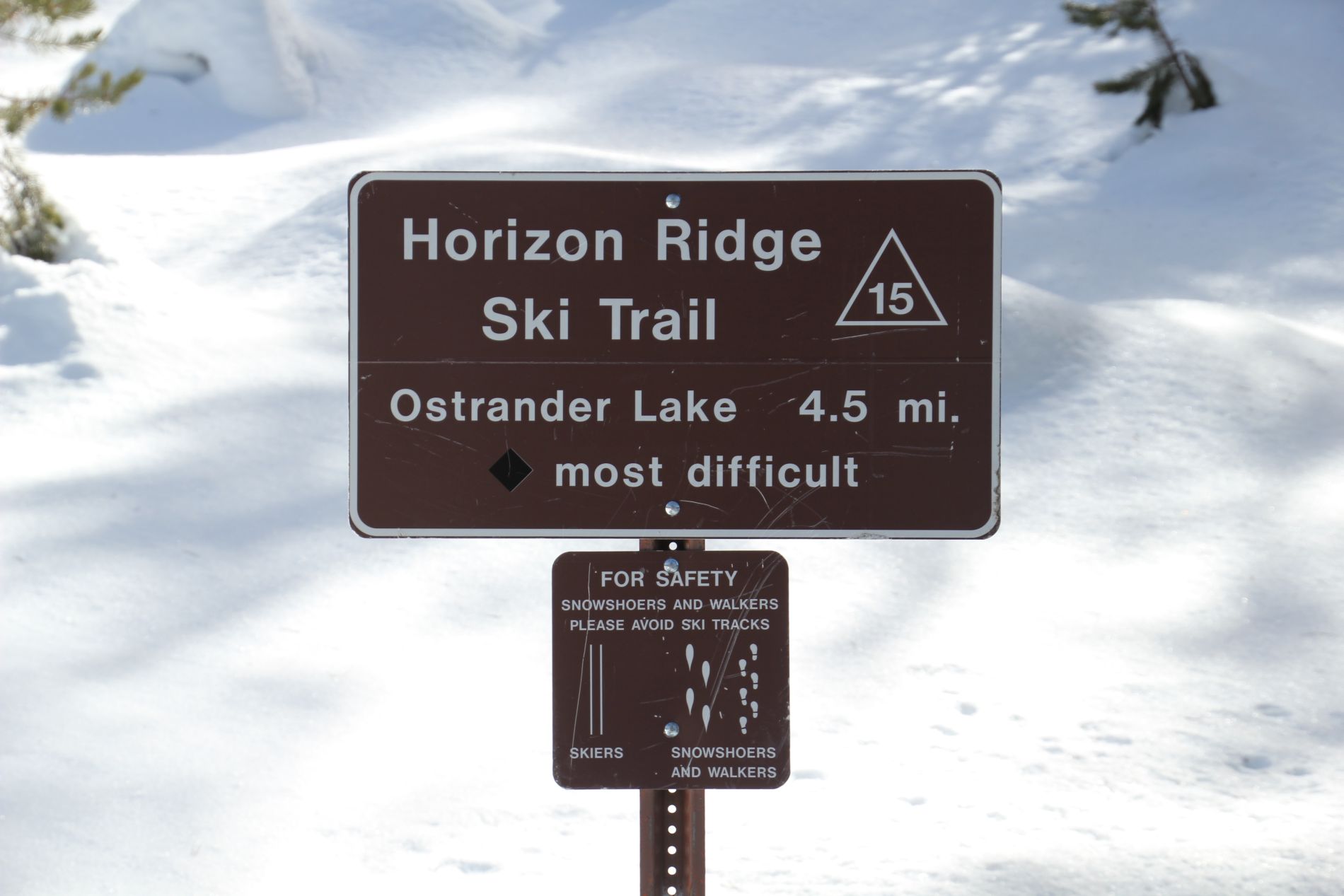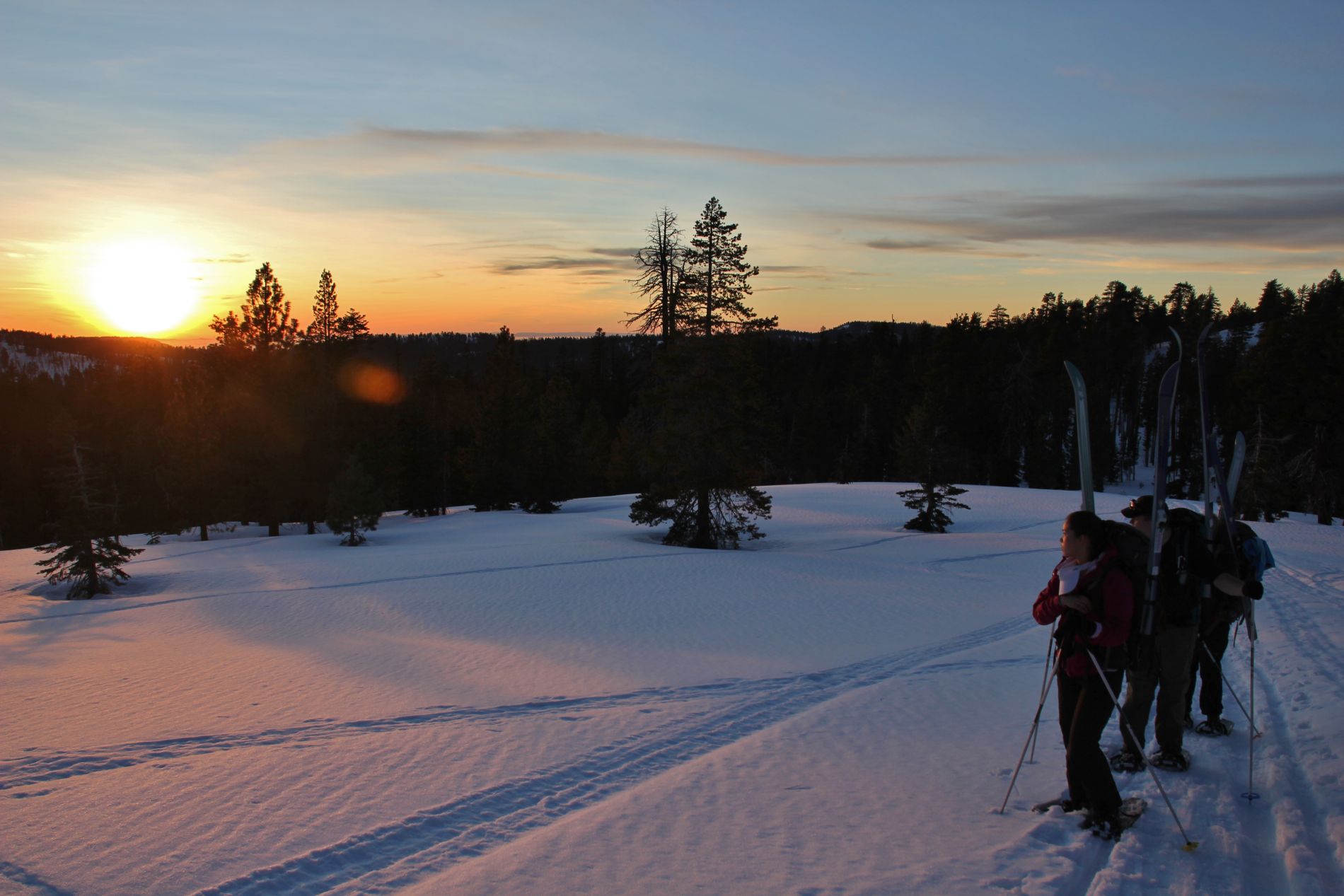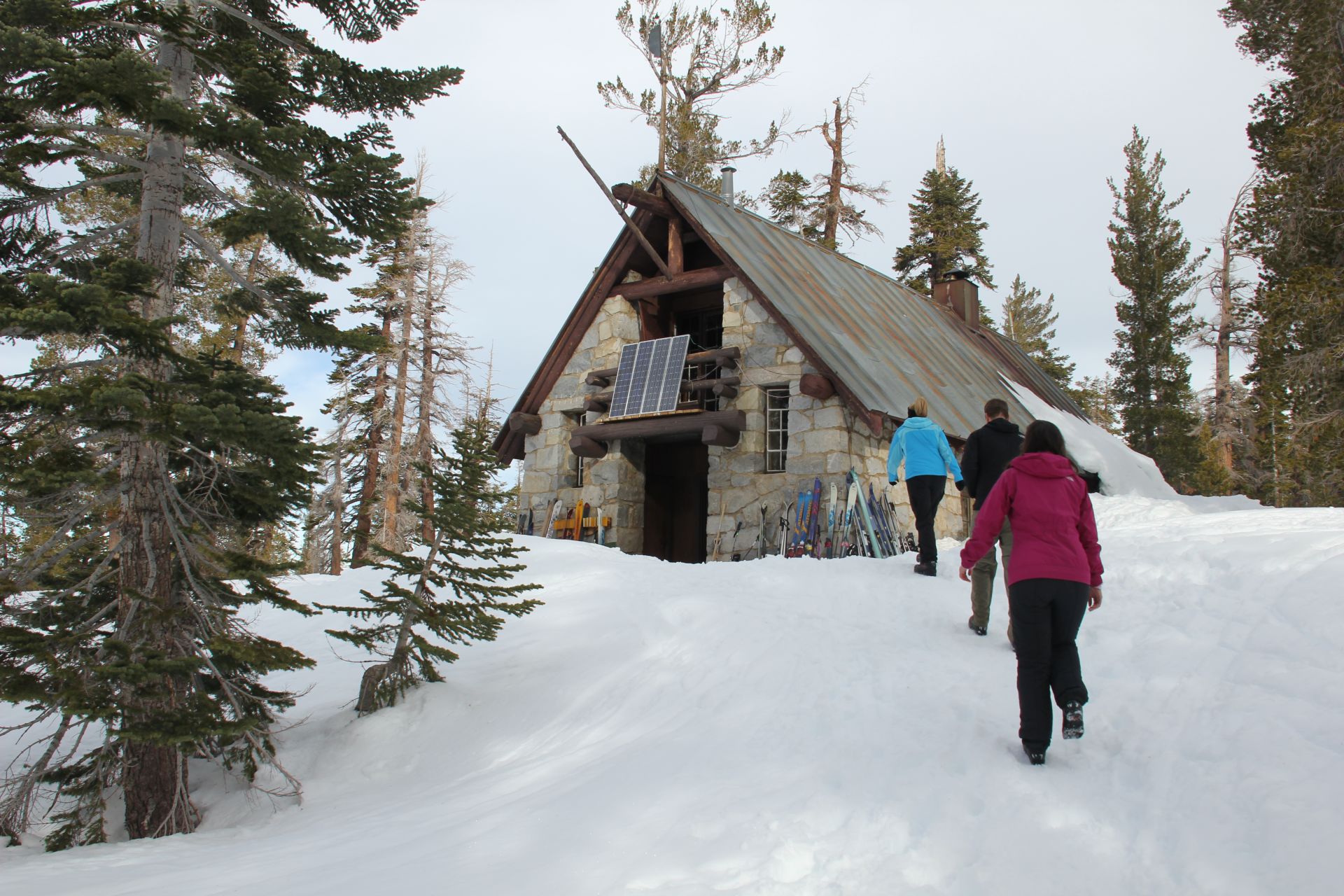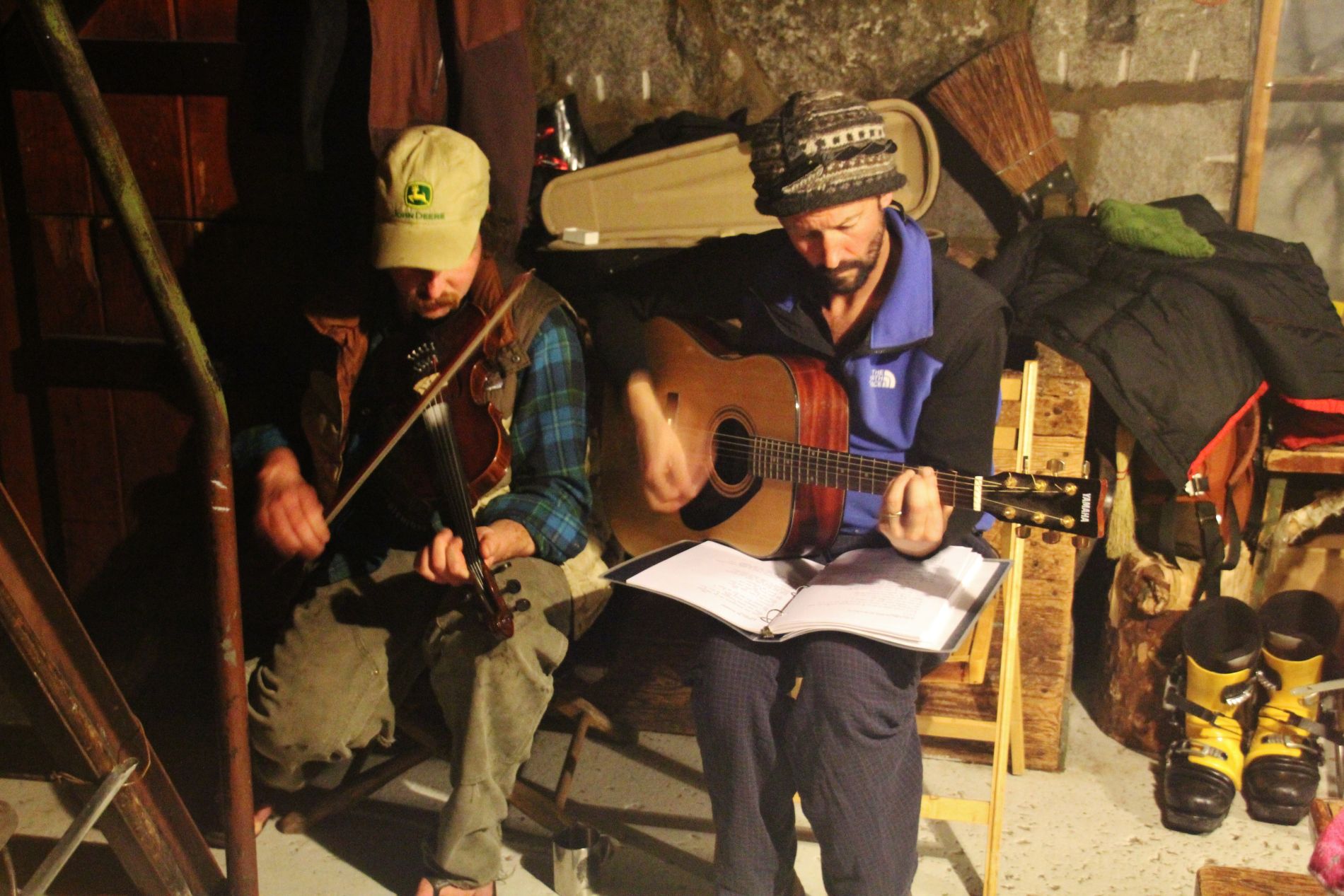AUGUST 2, 2011 — When I feel my pulse redlining after snowshoeing halfway up the steep, snow-covered Horizon Ridge toward another mountain called Heart Attack Hill, I start to doubt the wisdom of embarking on our journey, a cross-country skiing trip to Ostrander Ski Hut in Yosemite’s backcountry. I look behind me, but I don’t see my friends Elizabeth, Rich, or Wendy. I wonder if they’ve already turned back to protest the unexpected strenuousness of this skiing rite of passage, leaving me to fend for myself in the wilderness. We’re all novice cross-country skiers (Elizabeth had never worn a ski in her life before this morning), and we’ve made the mistake of getting ourselves into an intermediate-level cross-country skiing adventure. When I finally make it to the top of the Ridge, my neck and eyeballs feel like they’re going to burst in a disgusting spattering of bloody goo. To my relief, when I look behind me again, I see my friends. They look depleted, but they’re still trudging, on snowshoes instead of skis. Because the terrain is so steep and we couldn’t find a place to rent ski skins — which can be attached to skis to make walking uphill easier — we’ve brought snowshoes instead. Alas, using them requires us to remove our skis and strap them to our backs, adding an additional six pounds to our 25-pound backpacks.

The Horizon Ridge Ski Trail signs warns that the route is “most difficult.”
I’m afraid that if I stop for too long to wait for them that I’ll never get myself to move again, so I pull the skis off my backpack, snap my feet into the bindings, and begin skiing down the Ridge. I make a mental note to send a letter to Yosemite to suggest that they name this final descent before Heart Attack Hill: Coronary Artery Bypass Drop.
Just as I’ve reached a respectable pace, I feel my skis slide over a large patch of ice under a tree. Suddenly, I’m staring at a clear, blue sky with a bloody, icy scrape on my arm after having smashed into the ground. I’m lying immobile, anchored by my heavy backpack filled with food, a sleeping bag, and, of course, snowshoes. I suspect that I look a bit like a beached whale.
Elizabeth’s face interrupts my view of the sky.
“Another ice pit?” she says, grinning. For someone who has never skied before, her attitude and resilience is both impressive and embarrassing for the rest of us. This is the sixth time I’ve become prey to one of these “ice pits” (our invented name), which seem to form when the shade of a tree turns the soft snow below it into a miniature ice rink.

A hiker snowshoes up Horizon Ridge.
“Please,” I say in a tone of utter frustration. “Make the ice pits stop. There’s no way to avoid them because I can’t turn.” Even though I’m an experienced downhill skier, I find skiing on our cross-country skis to be an utterly different experience. Turning on the skis has proven impossible. Just as Elizabeth helps lift my backpack to help me stand up, I see Rich, a six-foot, 210-pound man barreling toward me, unable to turn or stop. Rich narrowly manages to avoid impaling me with his skis, but, when he hits the ice pit, he tumbles to the ground.
“Fucking ice pits,” Rich mutters. “This sure isn’t easy.”
“Easy is boring,” I say, trying to act as a cheerleader, even though the two of us look like we’ve been beaten with baseball bats made of ice. Grudgingly, when Wendy joins us, we continue down Coronary Artery Bypass Drop until we reach the starting point for the climb up Heart Attack Hill. We see the sun setting, but we know that we need only slog through two remaining miles before we’re sitting in the cozy hut, eating dinner. We start fantasizing.

Skiers watch the sunset from Yosemite’s Heart Attack Hill.
“Bread bowls,” I say.
“Chowder,” Rich says.
“Bacon,” Elizabeth says.
“Pinot Grigio,” Wendy says.
We feel our spirits lifting when, to our dismay, we look up and realize that the final two miles to the hut are almost completely uphill. We have already trudged up about 1,000 vertical feet over the course of one mile to get to the top of Horizon Ridge, but now, there’s another 700 vertical feet up Heart Attack Hill to go. The reasoning behind the Hill’s name becomes clear.
About halfway up our ascent, the sun has reached civil twilight, and I’m snowshoeing through a forest under a deep navy sky. I ravenously wolf-down a Clif Bar to get an energy boost, but I have nothing to wash it down because I’m out of water. Since I’m about 15 minutes ahead of the rest of the group, I want to stop and wait, but I’m positive that if I stop moving, I’ll immediately collapse and fall asleep on the snow. As the last shards of ambient light dissipate, I think I see a shimmer ahead of me and realize that I’ve made it to the ski hut. But, as I continue to weave through the forest to get closer to it, the shimmer disappears. Am I hallucinating? Is the trip to Ostrander Ski Hut making me go mad? I see another shimmer disappear and then another.

Hikers walk toward Yosemite’s Ostrander Ski Hut.
Finally, a bigger, blurry light comes into view. Just when I expect it to disappear, I see a small stone building with a rusted, tin roof, a chimney, and solar panels affixed above the entrance. When I drop my backpack and burst through the door, 20 other skiers, sitting on benches around a long, communal table, greet me enthusiastically. They’re all rosy-cheeked, drinking wine and playing cards, waiting for hot water to boil on the stove so that they can cook dinner. I’m so drained that I can barely bring myself to smile. I collapse on one of the benches, catatonic. Twenty minutes later, Wendy, Rich, and Elizabeth kind of fall through the door and join me on the bench.

Caretakers at the Ostrander ski hut treat guests to a fiddle and guitar concert.
Mercifully, the rest of the night becomes our Heart Attack Hill fantasy. While we feast on the potato-bacon chowder (prepared adeptly by Rich, the chef of our group), bread bowls, and wine that we’ve been carrying for ten miles, Ostrander’s caretakers treat us to a fiddle and guitar concert. Rich, also the musician of our group, joins in with a washtub bass that the caretakers produce from the kitchen. When we present Elizabeth with Rice Krispies Treats with candles that we’ve been secretly carrying for her birthday, the rest of the skiers join us in singing. Afterward, we use our last remaining ounces of energy to play a board game and socialize with the other skiers. We feel less embarrassed about our state of total exhaustion when the very-experienced skiers tell us that today’s route to Ostrander was the hardest they’ve ever done. Then, when we can’t stay awake for a second longer, we all crawl onto our strange beds, which hang from the Hut’s walls on chains, and we fall asleep immediately.
In the morning, after a breakfast of oatmeal and dried-blueberries donated to us by another friendly skier, we find it almost impossible to bring ourselves to leave our homey accommodations, newfound friends, and washtub bass behind. Nevertheless, our job obligations compel us to strap on our skis and head slowly back via Bridalveil Trail, a longer but purportedly gentler journey.
A couple miles later, I’m skiing full speed down the trail when I hit another ice pit and find myself staring at the sky. Soon after, Rich, Wendy, and Elizabeth also end up in the prone position after failing to navigate through an ice pit around a large, fallen log. We’re exhausted, but we’re laughing.
“Why don’t we ever do anything easy?” I ask Wendy.
“Easy is boring,” Wendy says.
How to Ski to Yosemite’s Ostrander Ski Hut
OVERVIEW: Built in 1941, Ostrander Ski Hut is a historic, two-story stone building, sitting next to Ostrander Lake in Yosemite National Park’s backcountry. It’s a strenuous 10-mile, 10-hour ski trip (each way) from Badger Pass. Because of the difficulty of all ski routes to Ostrander, this trip should be undertaken only by intermediate or expert skiers (or the masochistic). The Hut is open from late December to early April. Visitors must have reservations to stay at the Hut and must bring their own food, water filter, and sleeping bag. Bare mattresses, kitchen utensils, a stove, and hot water are provided by the Hut’s staff. Note that this trip requires a Wilderness and Parking Permit, which must be obtained at the National Park’s Badger Pass Ranger Station (the “A-Frame.”)
LOGISTICS: Early reservations for the Hut are awarded through a random lottery which takes place every year in mid-November. More information about the lottery can be found on the Yosemite Conservancy’s web site. Phone reservations can be made Monday through Friday, 8:30 AM to 4:30 PM, starting one week after the end of the lottery, though keep in mind that the Hut is usually totally booked by the lottery, at least through weekends. Email your name, address, phone number, and email address to ostrander@ yosmiteconservancy.org to receive an annual email announcement with lottery details.
GEAR: Yosemite’s Badger Pass ski area provides rentals of downhill skis ($31/day), cross country skis ($23/day), Telemark skis ($29.50/day) and skate skis ($27/day) with boots and poles. However, because the backcountry trails to Ostrander are not groomed and have steep hills and sharp turns, skiers will be most happy with metal-edged backcountry skis or metal-edged Telemark skis due to their increased maneuverability. We wish we had used them. Also, Badger Pass does not rent ski skins, which are almost essential when trying to hike up hills like Horizon Ridge and Heart Attack Hill with skis on. Ski skins cost about $140 per pair and usually must be trimmed to fit your skis, which is why buying a pair to use on rental skis doesn’t make much sense unless you always rent the same ski size. To avoid this problem, we chose to carry snowshoes and switched to them when encountering steep hills. But, keep in mind that this required us to carry skis strapped to our backpacks occasionally.
ROUTE: There are three trails that skiers usually take to Ostrander Ski Hut. Starting at the trailhead at Yosemite’s Badger Pass parking lot, follow the well-groomed Glacier Point Road for four miles. The first turnoff for Ostrander is marked with a sign for Bridalveil Creek trail, the easiest (longer, but flatter) route to Ostrander. About a half mile past this sign on Glacier Point Road is the turnoff for Horizon Ridge Trail, a steeper but shorter trail to the Hut. For expert skiers, the Merced Crest Trailhead is at the top of the Red Fox and Eagle chairlifts in the Badger Pass ski area. Most people ski the Merced Crest Trail by taking one of the easier routes to Ostrander and returning on Merced Crest Trail to avoid Merced’s steep uphill sections. View the route below or download the Without Baggage Horizon Ridge Ostrander Ski Hut GPS track in GPX or KML format.
I was hiking up to Ostrander the other week, contemplating how difficult the terrain would be on skis. But you're right, it's no fun if it's too easy!
Nice trip! Sounds like everyone makes the mistake of taking xc skiis for downhill adventure at least once 🙂 I did that last year so this year i wanted to try something else -rented a pair of telemarks and while they were a bit heavier and less stable on the flat sections, we were able to do some decent downhill skiing on the way back.